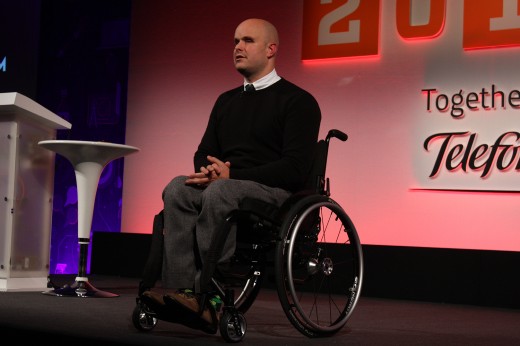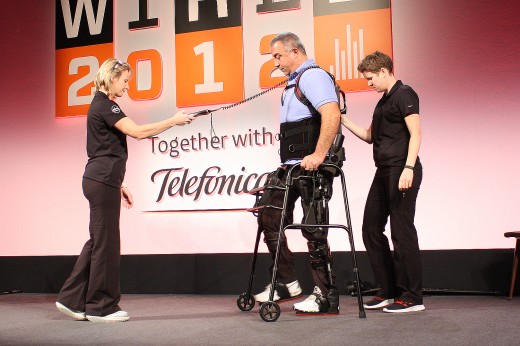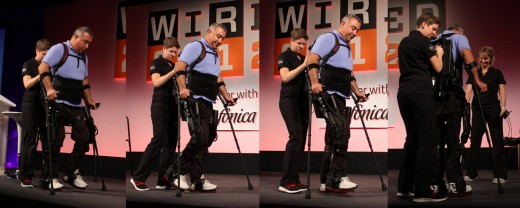
The Wired 2012 event took place over the past two days in London and was host to a number of great inventors, creators and entertainers. One particular talk brought home a real sense of why technology can be so exciting and inspiring.
Robotics is a field that can inspire all manner of reactions due to its breadth and scope. While some may imagine ASIMO the humanoid robot from Honda, others may think of Keepon, the sound reactive dancing robot that is available at the consumer level.
Robotics is not just about apparently autonomous figures though and when Mark Pollock took to the stage to give his presentation, you could have heard a pin drop as the audience listened to how robotics can change human lives.
Mark Pollock was a competitive rower when he was diagnosed with a detached retina and lost his sight aged 22. This didn’t seem to slow him down as he carried on as an adventurer running six marathons in the Gobi desert and a marathon at Mount Everest among other escapades. He is also the first blind man to race to the south pole.

“When I realised what was going on, I wondered whether dying would have been a better outcome,” he explained to the audience. “I didn’t choose any of it, the accident, the injuries, the consequences. I lay in intensive care, pumping morphine into my system to dull the pain. Hallucinating and slipping between reality and a dream state.”
It seems that Pollock’s strength of character is a trait recognised online. He got messages over his weeks in hospital on his blog, through Twitter and Facebook that sound a little harsh, but may have been the impetus of the coming years. People wrote to him saying things like ‘sorry about the accident, but it’s lucky it happened to you, you’ll be able to deal with it’, and so on.
“I’d written a book called ‘Making it happen’,” he said. “I didn’t find it offensive that people thought walking was going to be an option for me. That’s the story I’d been selling. Sometimes we choose challenges and sometimes challenges find us. What we do next is important.”
Mind over matter
Over the last two years, Pollock sought out people who think differently and ambitiously when it comes to rehabilitation. He was spent six months in hospital having operations and as he came to the end of his treatment he found that conventional thinking said he would be paralyzed for the rest of his life.
Pollock became interested in ignoring doctors and finding innovators. He went to California and found Project Walk Spinal Cord Injury Recovery where people don’t listen to conventional ideas but work on exercise to reconnect the brain to the body.
Pollock has trained for a year and is now starting to reconnect to parts of his body below the level of injury. In February this year he returned to California and Project Walk and confirmed that he had been making progress. While in the States he also visited a company called Ekso Bionics. “If Project Walk are trying to fix it from the inside out, Ekso Bionics are trying to fix it from the outside in.”
Ekso Bionics is was originally called Berkley Bionics. The company was founded in 2005 and it is a pioneer in exoskeletons.
If you’ve seen too many cartoons, the term exoskeleton might bring about visions of huge flying robots making battle in the skies over some future dystopic city. The reality is much, much cooler. These exoskeletons help people walk again.
On stage Pollock handed over to Lynne Vale, a physiotherapist of Ekso Bionics. She explained how its intelligent exoskeleton works with a live demonstration.
Lynne’s colleague Sandy also came to the stage with a gentleman named Andy who is paralyzed from the rib cage downwards due to an accident around 20 years ago.
Andy moved from his wheelchair into the exoskeleton and initially with the help of a walking frame and then with triggers in the handles of a pair of crutches, Andy walked around the stage. Take a look at the pictures.

“There’s no question about it, sustaining a spinal cord injury is a life changing event,” said Vale. “A level of your independence is lost when you become paralyzed. But now a person who has been told they will never walk again has a real option to stand and walk.”
The Ekso bionic suit is worn by people with neurological weakness and who are dependent on a wheelchair. It’s a training device designed to improve function and independence. It moves the patient’s legs through a normal walking pattern.

The suit is designed for use in a rehabilitation facility rather than stomping off down the shops. People who use them still need to be supervised by physiotherapists. It’s also designed for use by multiple patients and so it can be adjusted to different heights and widths.
“I’ve upgraded my ambition from walking again,” said Pollock. “If you say you’re going to walk again, you might as well run again, so that’s the new ambition. I plead with you inventors, creatives, artists and business people if you can come up with a solution I’m up for it, but the people who are hot property for me are Ekso Bionics.”
There are many things we can focus on when it comes to the development of technology, but there are few that would create the sense of achievement that the engineers at Ekso must have. Following this presentation at the event, the audience gave Pollock and the Ekso team a standing ovation.
Wired must have changed some minds in the room by presenting this technology at the event. When you see something like this happen, you know it’s time to quit your bitching and go make something that matters.
Get the TNW newsletter
Get the most important tech news in your inbox each week.





